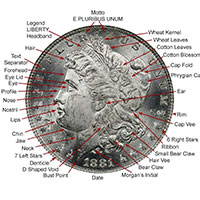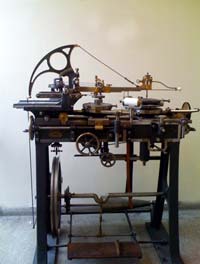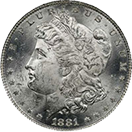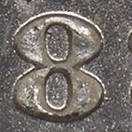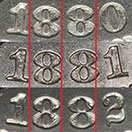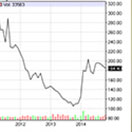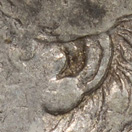
What Is A VAM?
Sources
Search
Contact
Home
The VAMs
What Is A VAM?
Interest & Rarity
Hubs to Dies
New VAM Variety
Obverse Dies
Reverse Dies
Clashing
What is a VAM?
The acronym VAM originates with the introduction of the study of die differences in Morgan dollars by George Mallis and Leroy C. Van Allen, and is an abbreviation of their names. They published their original findings over 40 years ago, and the identification and study of VAMs has continued to the present.
VAMs originate when a new die or die combination for a coin is recognized. While die differences can occur during the die creation process, these variations also occur as a result of factors like wear, polishing, clashes, gouges, and other distinguishing features.
If you really want to discover the coin making process and how differences are introduced to coins that create VAM varieties, then please read the section titled "New VAM varieties" in the menu.
What makes a new die variety?
Since almost every Morgan has distinguishing characteristics, especially under magnification, the question is then "What defines a VAM, or new variety?"
It might be helpful to understand what does not constitute a new die variety. Most Morgan dollars have hairline die cracks that appear on the coin in various places, so small die cracks do not constitute a different die, just die wear. These can be used to identify a particular die when they consistently appear, but that is all.
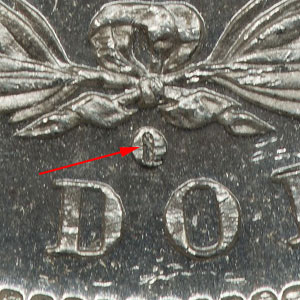 Strike doubling is also a common misconception in VAMing. It takes a little practice to know the difference in strike doubling and die doubling, but once you know you will know. Strike doubling most often has a flat appearance, whereas die doubling retains a softer rounded look as it would have been if the elements were separate items.
Strike doubling is also a common misconception in VAMing. It takes a little practice to know the difference in strike doubling and die doubling, but once you know you will know. Strike doubling most often has a flat appearance, whereas die doubling retains a softer rounded look as it would have been if the elements were separate items.
For a complete discussion of die varieties on VAMworld provides much more detail than we discuss here. Click here to go to that discussion.
Rarity and Interest
There is a brief discussion of the rarity and interest in each VAM, but this is covered in much more detail on an individual coin basis. Instead we really focus on a discussion of rarity and interest as an overall topic.
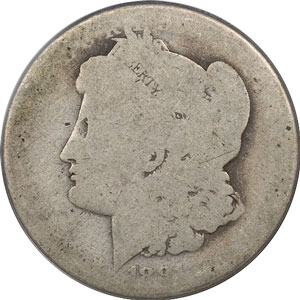 Hopefully there is some different thinking about how to look at these topics, and how they combine to create the most collected or coveted coins. This discussion has a section of its own in the menu on the left.
Hopefully there is some different thinking about how to look at these topics, and how they combine to create the most collected or coveted coins. This discussion has a section of its own in the menu on the left.
Our VAMs
The VAMs in our collection are listed and shown under the "Our Collection" tab above. They are grouped and cross-referenced by both grade and VAM. One can easily compare items within grade and see multiple examples of all VAMs there.
Of the all the VAMs for the 1881-O listed on VAMworld, we have identified most in our collection and we are narrowing in on them all. We almost always have coins in the "pipeline" to identify, and grade, so our collection will continue to grow.
From a goal perspective, we would definitely like to close any gaps we have on the list of VAMs. But more importantly we hope we continue to find discovery coins by focusing on this one date and mint.
There should be a lot of hope for discoveries given that there were four new 1881-O VAMs recognized in 2014, seventeen in 2015, and another three so far in 2016. Additionally there are revisions to existing VAMs as we learn more.
This same opportunity exists for all date and mint combinations, so dive in.
Why the 1881-O?
When it gets to VAMs and beginning to understand them at first simpler is better. The 1881-O falls into this category. With only one obverse and one reverse hub type, a collector is not concerned with identification of those features. Other features often requiring precision, like date placement or over-dates, are not a factor.
For the 1881-O the discussion is reduced to obverse and reverse die pairing. Even the die discussion can get to be complex, but with just over seventy VAMs the challenge is conquerable.
As mentioned elsewhere, affordability is a key issue. VAMs are most easily identified in mint state coins, and the 1881-O is easily affordable all the way to grade 64. Grades 65 and 66 will make you gasp, but only for the comparison of grading are they needed.
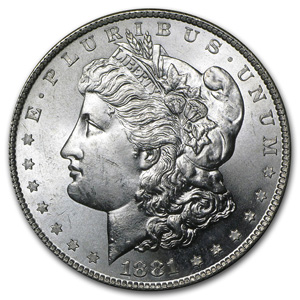 With all Morgan Dollars the upper grades get expensive. There are plenty of Morgans, just not plenty of high grade mint state Morgans.
With all Morgan Dollars the upper grades get expensive. There are plenty of Morgans, just not plenty of high grade mint state Morgans.
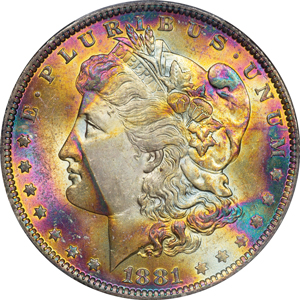 And then there are toned coins. We find plenty of toned 1881-O coins and this area of study is both interesting and enjoyable.
And then there are toned coins. We find plenty of toned 1881-O coins and this area of study is both interesting and enjoyable.
Getting Started
Collecting The 1881-O
The 1881-O VAMs
